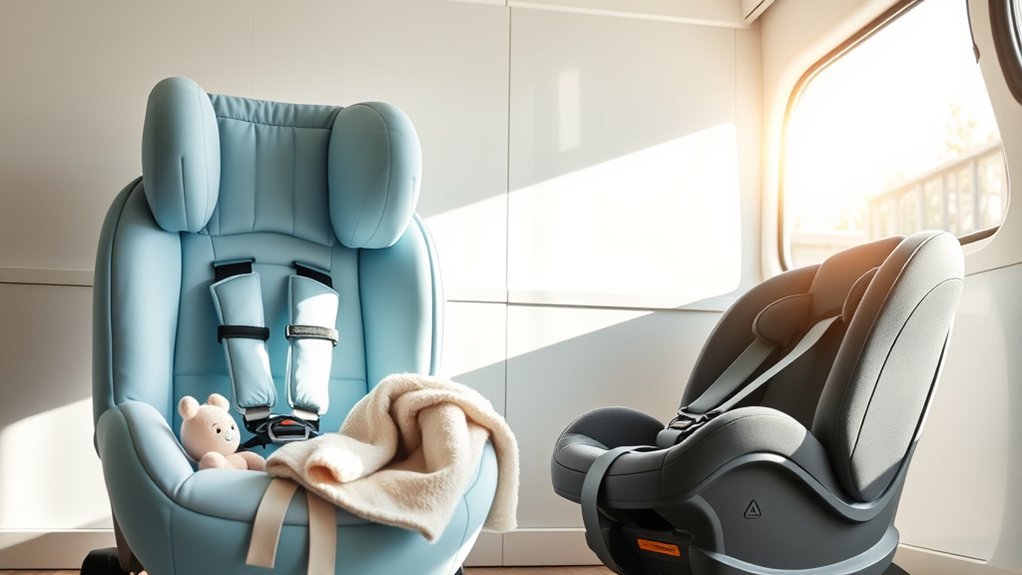When it comes to car seats, are you really sure you know the best option for your child? Understanding the differences between infant and convertible seats is vital for their safety. Each type serves a unique purpose and has specific guidelines you should follow. Before you make a decision, it’s important to reflect on the do’s and don’ts that can impact your child’s protection on the road. Let’s explore these essential factors.
Understanding Infant Car Seats
When it comes to your baby’s safety, understanding infant car seats is essential. These seats are specifically designed for newborns and infants, offering critical protection during car rides. They feature a rear-facing design, which is the safest position for your little one.
Confirm the seat fits snugly in your vehicle and follows the manufacturer’s installation guidelines. Always use the harness system properly; it should lie flat against your baby’s body, with the clip positioned at armpit level.
Keep your infant in the car seat until they reach the weight or height limit specified by the manufacturer. Regularly check for recalls and expiry dates, as outdated seats may not provide adequate protection.
Prioritize your baby’s safety by choosing the right infant car seat.
Exploring Convertible Car Seats
While infant car seats are essential for your baby’s early months, convertible car seats offer a long-term solution as your child grows.
These versatile seats can shift from rear-facing to forward-facing, adapting to your child’s size and developmental needs. Here are three key features to take into account:
Convertible car seats adapt from rear-facing to forward-facing, ensuring safety and comfort as your child grows.
- Longevity: Convertible seats can accommodate children from infancy up to around 65 pounds, making them a cost-effective choice.
- Safety: They often come with advanced safety features like side-impact protection and multiple harness positions, guaranteeing your child remains secure.
- Ease of Use: Many models are designed for easy installation and adjustment, simplifying the shift between rear and forward-facing positions.
Choosing a convertible seat guarantees your child stays safe and comfortable throughout various growth stages.
Do’s for Choosing the Right Car Seat
Choosing the right car seat is essential for your child’s safety and comfort. Start by selecting a car seat that matches your child’s age, weight, and height.
For infants, look for rear-facing seats that offer the best protection. If your child is older, consider a convertible seat that can grow with them.
Always check for safety certifications, such as the FMVSS label, to guarantee compliance with safety standards. Make sure the car seat fits securely in your vehicle; it shouldn’t move more than an inch when installed correctly.
Additionally, familiarize yourself with the manufacturer’s instructions for installation and adjustments.
Finally, register your car seat to receive recall notifications and stay informed about safety updates.
Don’ts to Avoid When Selecting a Car Seat
Selecting a car seat requires careful consideration, and there are several pitfalls to avoid to guarantee your child’s safety.
Here are three vital don’ts:
- Don’t choose based on price alone: A cheaper seat may lack essential safety features. Invest in quality for your child’s protection.
- Don’t ignore the expiration date: Car seats have a lifespan. Using an expired seat can compromise safety due to worn materials.
- Don’t skip the installation manual: Always read the manufacturer’s instructions. Incorrect installation can lead to dangerous situations during an accident.
Transitioning Between Car Seat Types
Understanding the differences between infant and convertible seats is essential as your child grows. Shifting from an infant seat to a convertible seat typically occurs when your baby outgrows the weight or height limits of the infant seat, usually around one year old.
Make certain to check the manufacturer’s guidelines for both seats. When making the switch, verify the convertible seat is installed correctly, using either the LATCH system or seatbelt, and follow the instructions carefully.
Your child should remain in a rear-facing position until they reach the seat’s specified weight limit, which is often up to 40 pounds.
Finally, always keep your child secured with the harness, adjusting it as needed to fit snugly for maximum safety.
Frequently Asked Questions
How Long Can a Child Use an Infant Car Seat?
A child can typically use an infant car seat until they reach the weight limit, usually around 22 to 35 pounds, or until their head is above the seat’s top. Always check the manufacturer’s guidelines.
Can I Use a Convertible Seat for Newborns?
Can you really use a convertible seat for newborns? Yes, you can, but verify it meets safety standards and offers a proper recline. Always check the manufacturer’s guidelines to assure your baby’s safety and comfort.
Are There Weight Limits for Infant Seats?
Yes, infant seats have specific weight limits, typically ranging from 22 to 35 pounds. Always check the manufacturer’s guidelines for your seat to guarantee your baby’s safety and proper usage as they grow.
What if My Car Doesn’T Have a LATCH System?
If your car doesn’t have a LATCH system, securing your car seat with the seatbelt is like fastening a life jacket. Make sure you follow the manufacturer’s instructions for installation to guarantee safety.
Can I Install a Car Seat Without a Base?
Yes, you can install a car seat without a base. Just use the vehicle’s seatbelt to secure it tightly. Make sure it’s correctly positioned and doesn’t move more than an inch when you pull it.
Conclusion
In choosing the right car seat, prioritize safety above all, guarantee a proper fit for your child, and stay informed about recalls. Embrace the benefits of rear-facing infant seats for newborns and convertible seats for growing toddlers. Avoid shortcuts like cheap options and expired seats, and always read the installation manual. By following these do’s and don’ts, you can confidently protect your child on the road, making informed decisions that safeguard their safety now and in the future.
